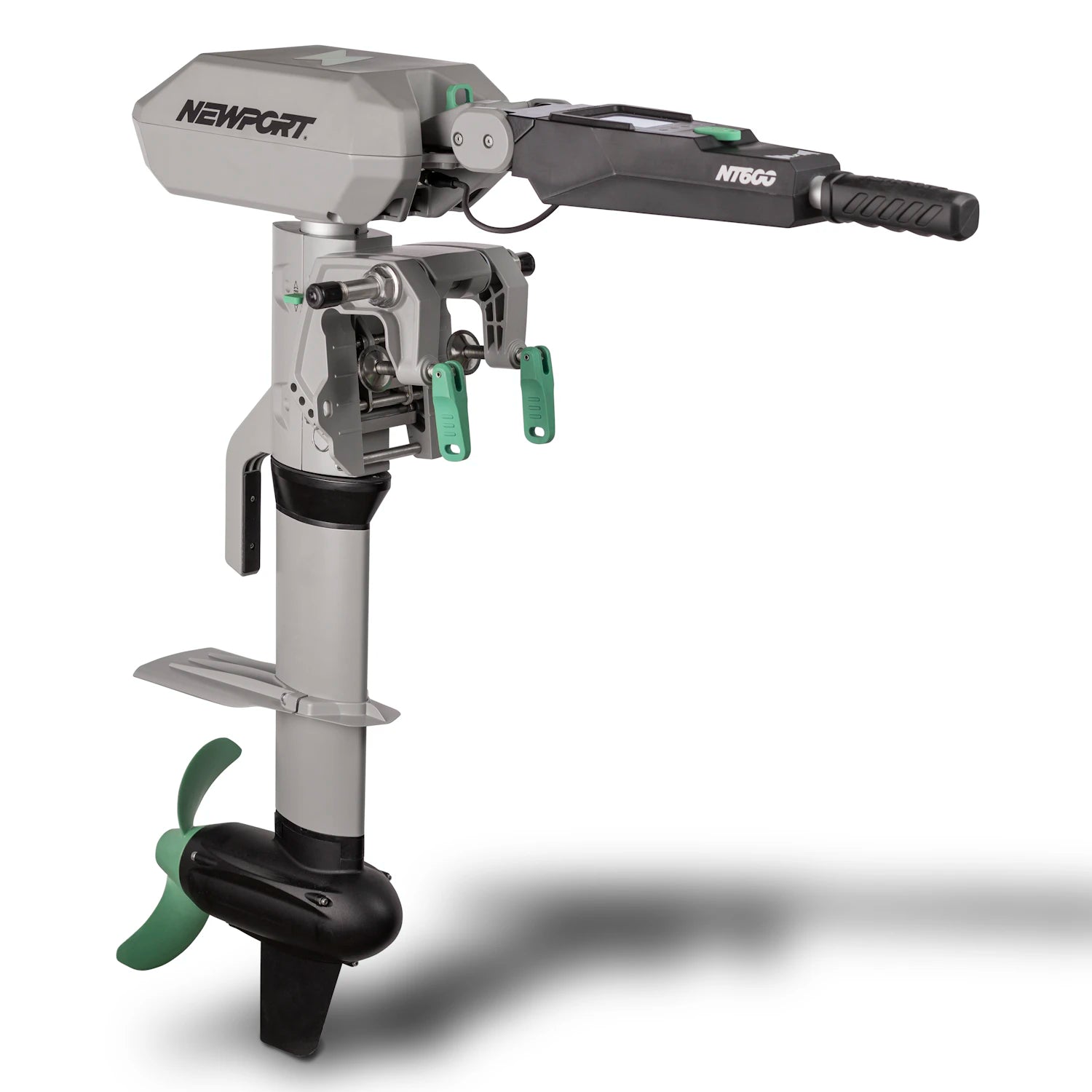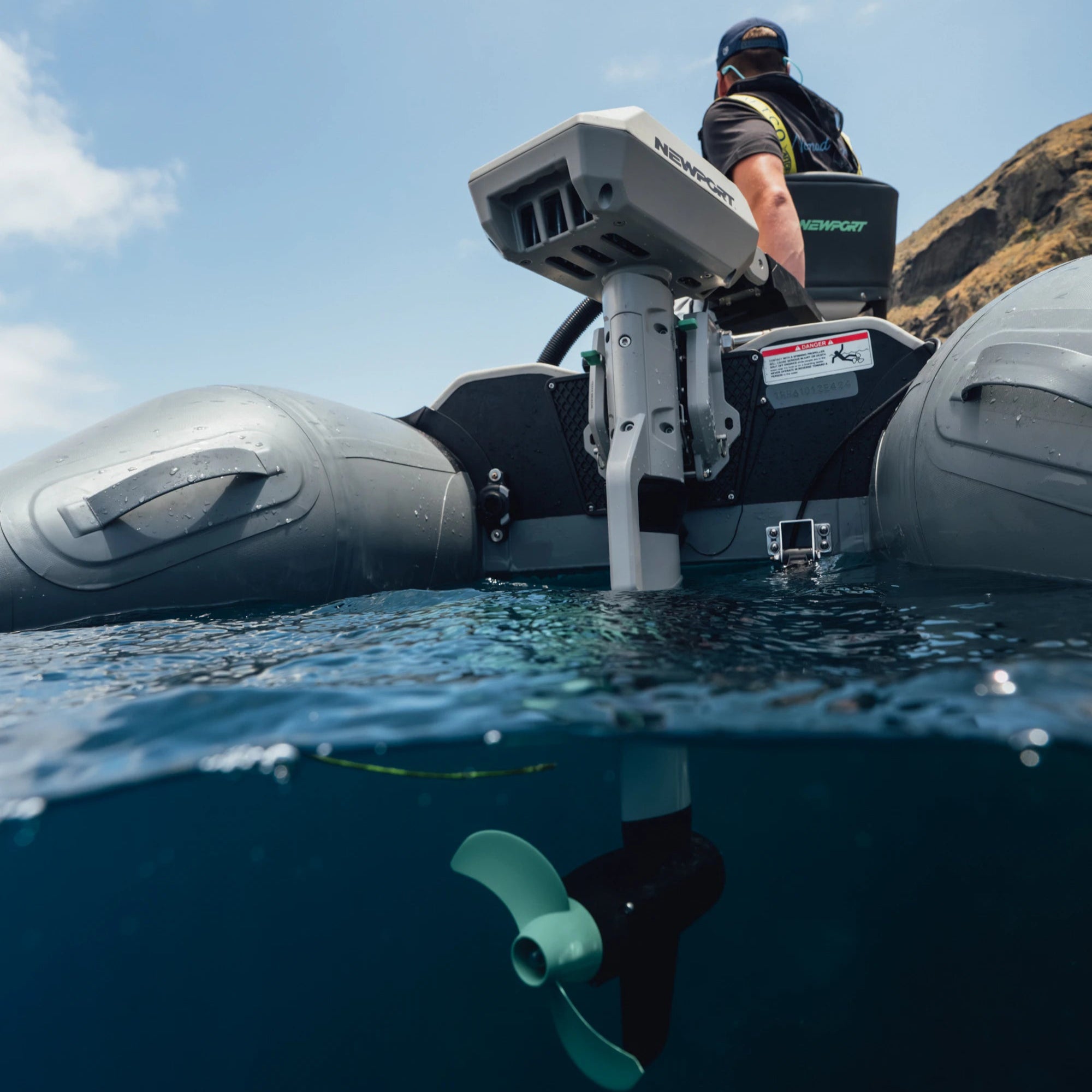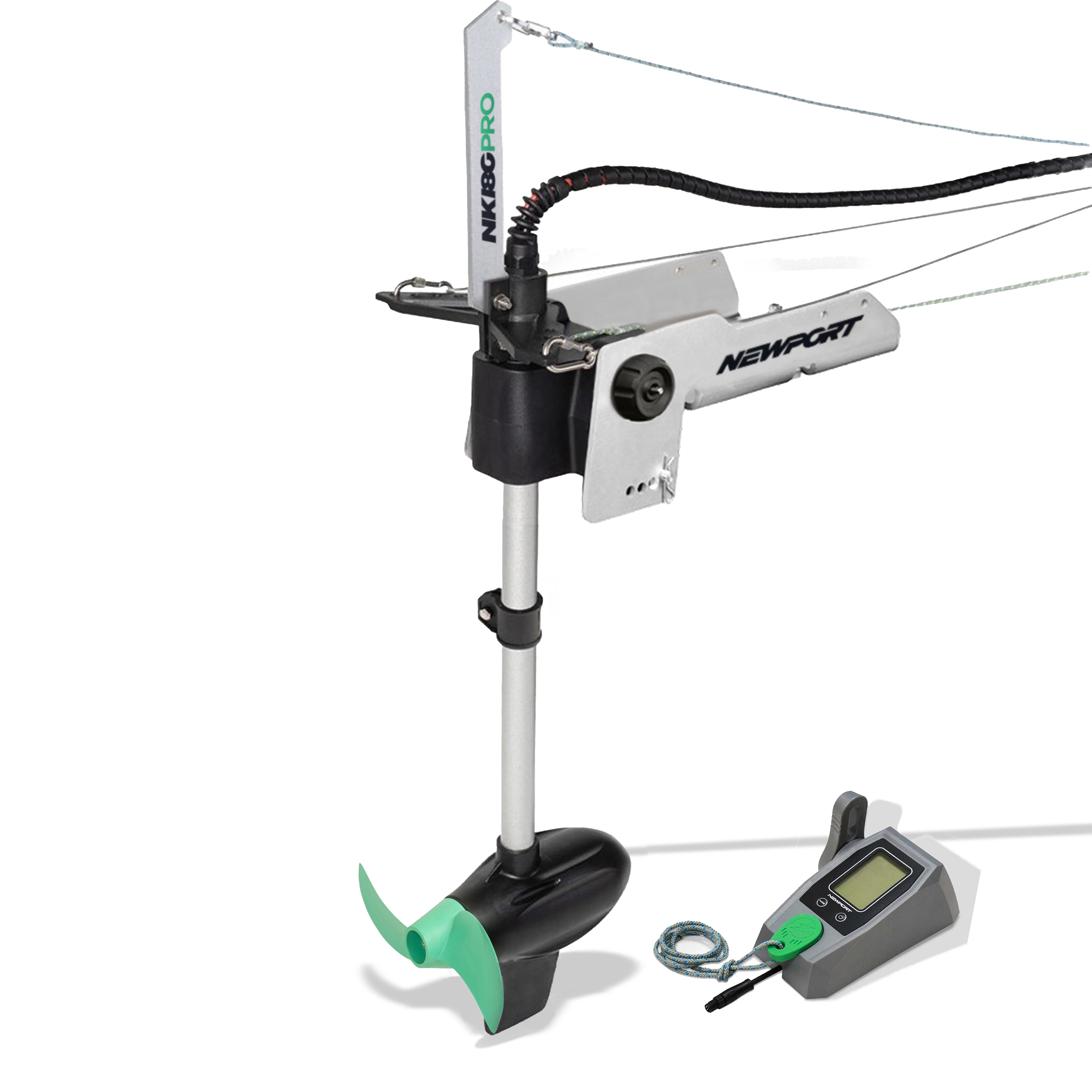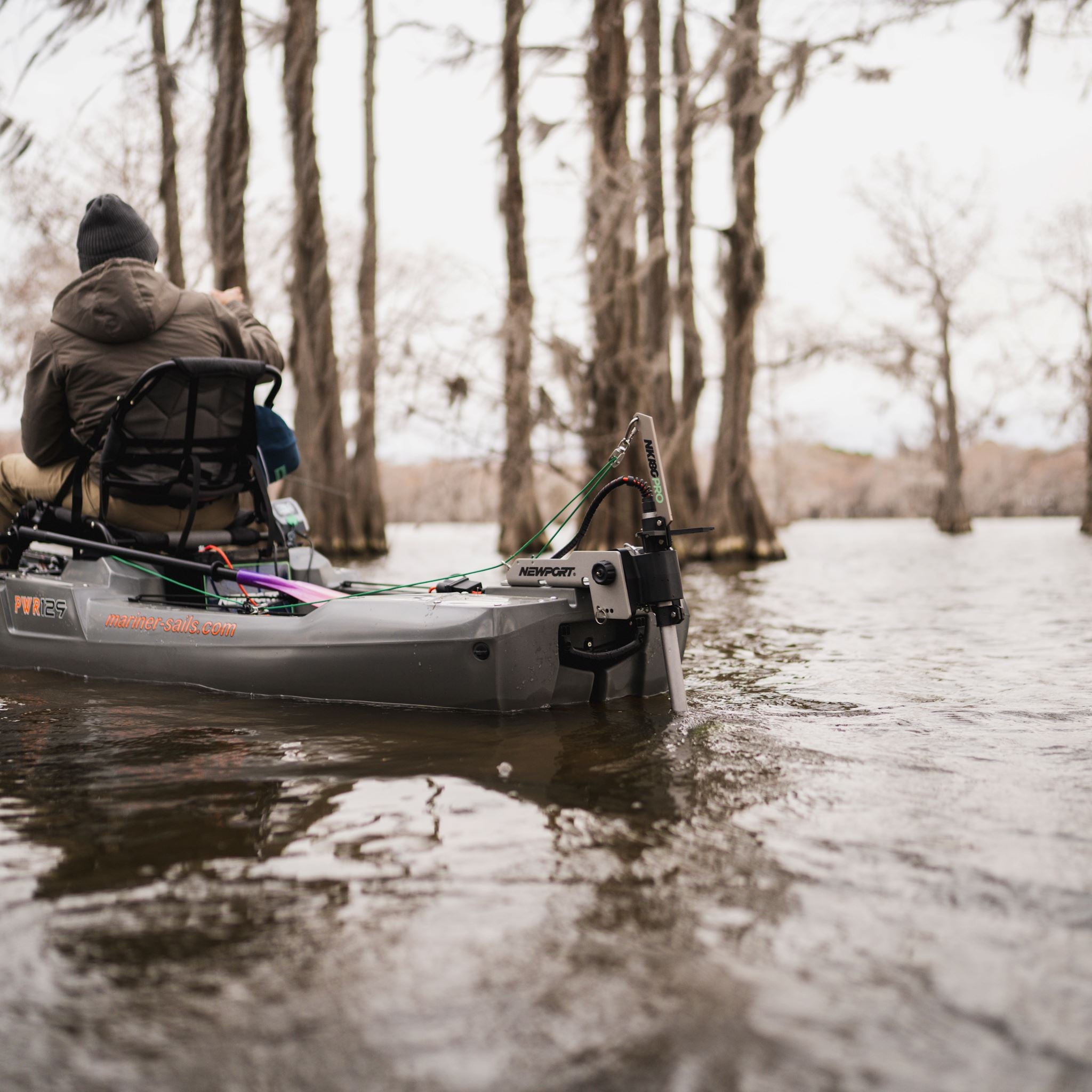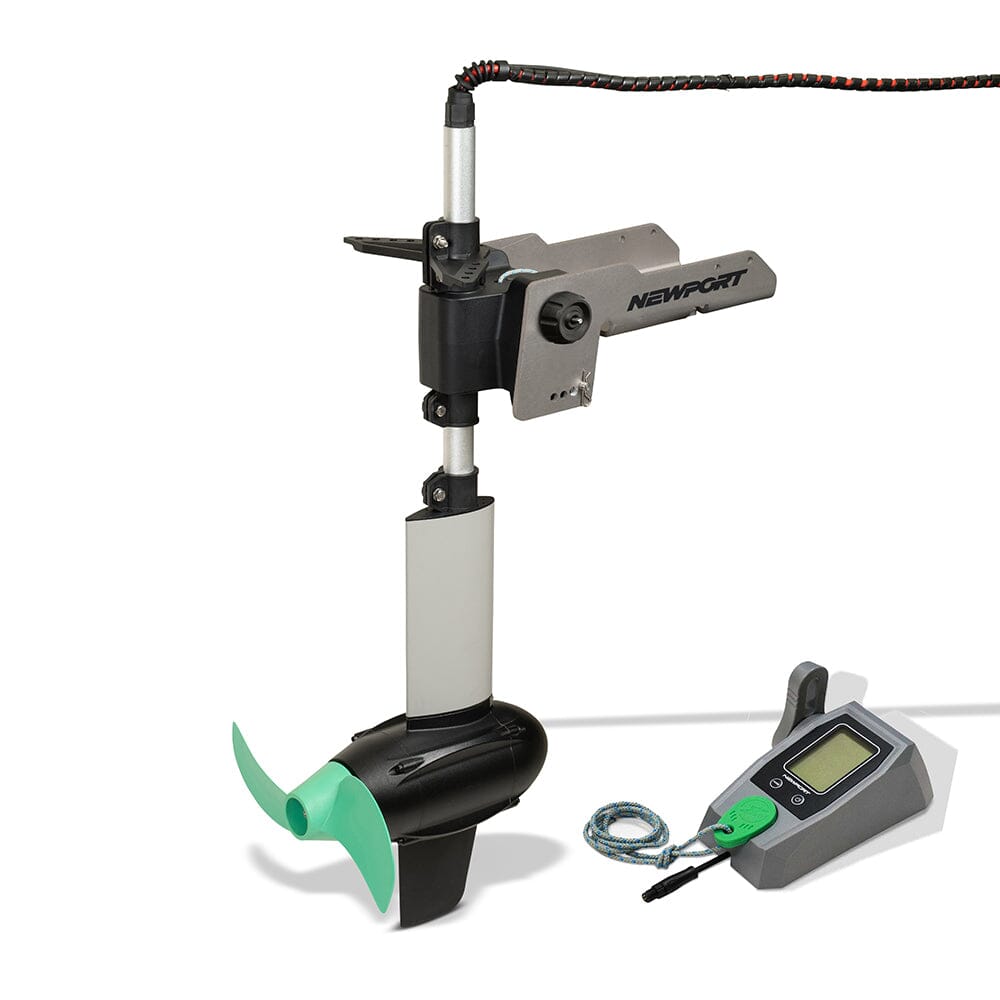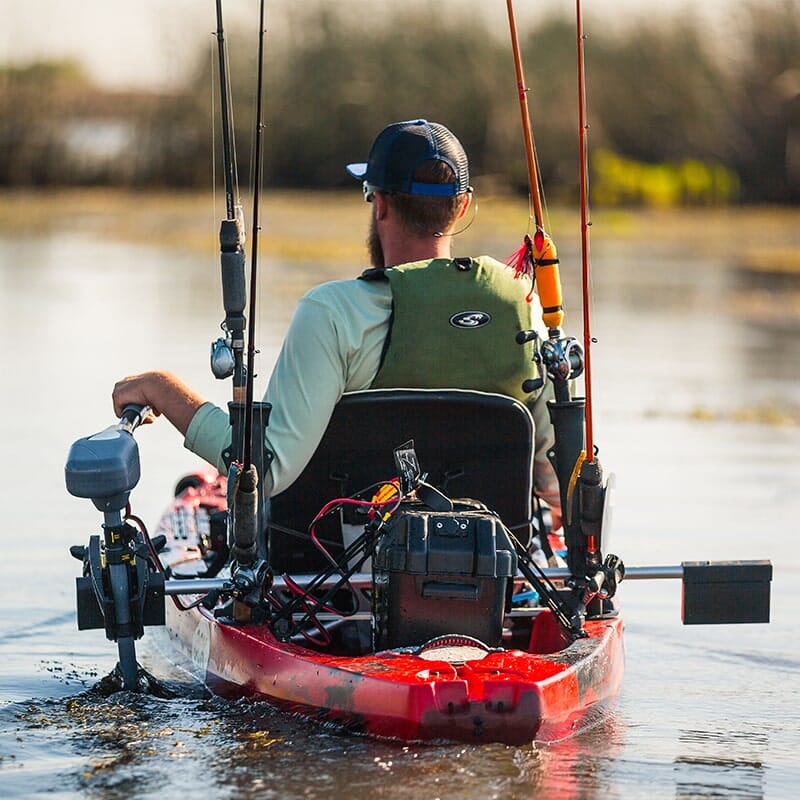Many factors go into effectively setting up a kayak with a motor. These include the kayak’s intended use, the vessel’s total weight, water conditions, and motor mounting positioning. This article will help you set up a trolling motor on your kayak so you can go on your next adventure.
Quick Recommendations
For a quick Trolling Motor recommendation please see our Choose Your Trolling Motor Guide! This guide will ask you a few questions, and it will recommend the motor thrust and shaft length for your kayak! Please read on for more information on choosing a trolling motor.
If you are looking to increase your speed with an electric outboard motor, see our NK180. To see if this electric outboard motor is compatible with your kayak, check out our NK180 Compatibility Guide. See our NK180 YouTube Playlist for in-depth installation instructions.
Main Topics:
- How Much Thrust is Needed?
- What Shaft Length is Needed?
- Do I Need a Mount? Which One Should I Purchase?
- Battery Types, Amperage, and Weight
- Pros and Cons of using Lithium Batteries
- Where to Store a Battery on a Kayak?
- Are Extension Cables Needed?
- Propeller Sizes, Compatibility, and Benefits
- How to Transport and Launch Your Kayak?
1. How Much Thrust is Needed?
Thrust cannot be measured with a scale, nor can it easily be converted to the common horsepower rating. More horsepower does not always equal greater top speed because many trolling motors run at similar RPMs. For example, a 36lb thrust motor can reach a speed of about 3 mph, whereas an 86lb thrust motor can reach about 4.5mph. See our Trolling Motor Performance and Speed article for more information on this topic.
Trolling Motors
A trolling motor paired with the recommended weight and conditions will produce speeds between 3-4.5mph. More thrust is needed for heavier vessels, to combat chop, current, or wind. Some customers may have less total weight for their boat but require more thrust to combat the current on a river they fish on. It’s important to note that you can always purchase a larger motor and use it at lower speeds for your application.
Examples:
- Kayaker A has a total weight of 300lbs, including the boat, person, and gear may use a 36LB Thrust Kayak series Trolling Motor on calm water with little wind.
- Kayaker B has the same weight but regularly experiences wind on a larger lake and a mild current on a river. This person may want to use the 55LB Thrust Motor.
- Finally, Kayaker C regularly fishes in ponds with a total weight of 450lbs with no wind or chop could use the 46LB Thrust NV Series Trolling Motor.
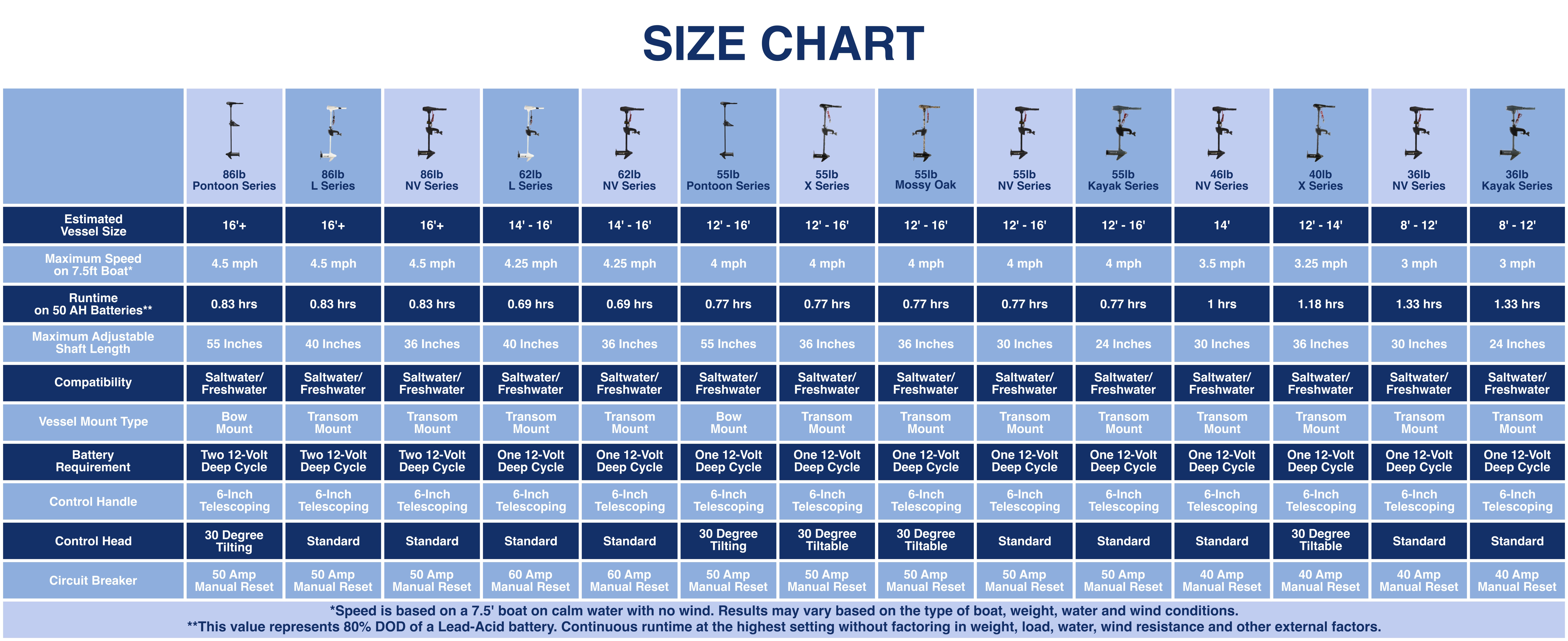
Essential consideration:
- What is the total weight of the boat?
- The weight includes the boat and everything inside it.
- What are the water and wind conditions you expect to be in?
- Calm water, chop/swells, or wind?
This information will help us recommend the correct motor for your needs so you can get on your next adventure!
NK180
We have recently released our NK180, our first electric outboard. It’s rated at 60lbs of thrust and is 1.8HP equivalent. This electric outboard motor uses direct-drive brushless technology. This is more efficient and produces higher speeds than any trolling motor Newport sells. This motor will easily push your kayak, considering most vessels weigh less than 600lbs. A 1.8hp motor is an excellent option for kayakers as it can offset some current in a river or some chop in the ocean.
The most powerful trolling motors are limited to about 4.5mph and require much larger lead-acid batteries. In the right conditions, the NK180 can reach up to 5.4mph! The motor can use lithium or lead-acid batteries, either a single 24v or two 12v in series. Trolling motors use more power and require larger batteries to travel longer distances because they use less efficient technology. The NK180 utilizes direct-drive brushless technology, which means greater efficiency, smaller batteries, and longer distances.

For comparison, a 62lb trolling motor with 15AH of power would run for roughly 20 minutes at speed five or 55 minutes at speed three. These charts show that the direct-drive brushless technology is much more efficient than the brushed technology in trolling motors.

With variable speed, the NK180 allows precise adjustments to speed for any application, whether it’s trolling or full steam ahead! Please see our Pulse Width Modulation Guide if you want to create variable speeds on your trolling motor.
2. What Shaft Length is Needed?
Trolling Motors
Choosing the correct shaft length for your kayak is essential. This will help you to avoid cavitation bubbles, the propeller hitting your kayak, and excessive drag. To ensure you are getting the correct shaft length, you will need to measure the distance from the top of your motor mount location down to the waterline. You can take this measurement and apply it to the chart below to find the recommended shaft length. These measurements aim to have the propeller 12 inches below the water line to achieve optimal motor performance.
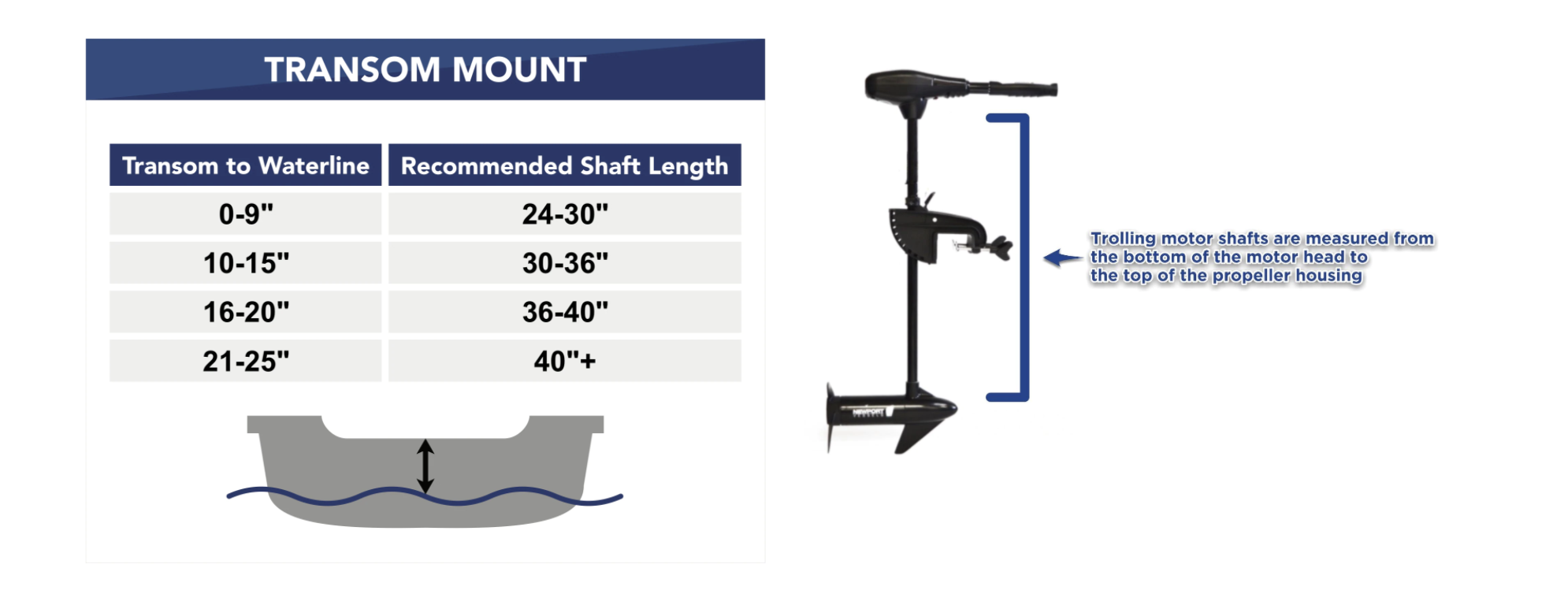
Generally, 24 or 30-inch shafts are used on Kayaks because they are close to the water. Regardless, we strongly recommend measuring your kayak to ensure you get the correct shaft length to avoid returning or exchanging your motor. For more information on this topic, see our Trolling Motor Shaft Length Guide.
NK180
The NK180 has a 19.7” shaft and a four-bolt mounting bracket. This design allows you to adjust the motor’s angle and depth in the water. When deciding if the shaft length is right for your setup, you should consider that the propeller should be at least 2 inches below the surface of the water. For more information on adjusting the mount, see the NK180 manual on our Owners Manual Page. Also, please see our Installation YouTube Video to understand better how this motor is mounted on a kayak.
3. Do I Need a Mount? Which Mount Should I Purchase?
Trolling Motors
There are several popular ways to mount a kayak; side mount, square back transom mount, through the drive pod, and using a stern mount. See our article called ‘Kayak Motors: Choosing the Right Trolling Motor Mount’ for a few motor mount options.

In the process of searching for the mount that works best for you, there are a few things to keep in mind:
- How high will the motor be sitting now that your mount is on the boat?
- This will affect the shaft length of the trolling motor you choose.
- How do you plan on steering the trolling motor?
- Customers who plan to mount their motor on the kayak’s stern should consider the Newport Tiller Extension Handle, which provides the length and comfort to operate the motor from a distance.
- Are you able to access the areas needed to install the mount?
|
Pros |
Cons |
|
|
Side Mount |
|
|
|
Transom Mount |
|
|
|
Drive Pod |
|
|
|
Integrated Mount: NK180 |
|
|
Drive Pod Measurements
Some kayakers will install the trolling motor into the kayak through a drive pod to operate the motor from their seat. The lower motor measurements are under the Tech Specs section for the length and width. It should be noted that if your trolling motor comes stock with a 3 blade propeller, you will need to purchase a 2 blade separately. For our 2 Blade -Small propeller, the width when the blades are vertical is 3.5”. For the 2 Blade - Large propeller, the width when the blades are vertical is 4”.
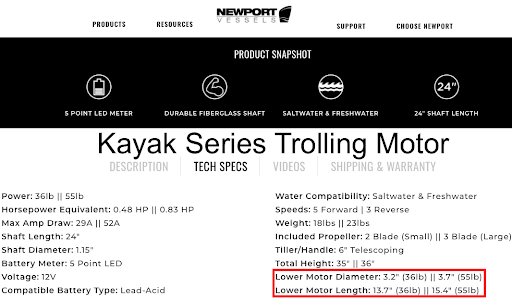
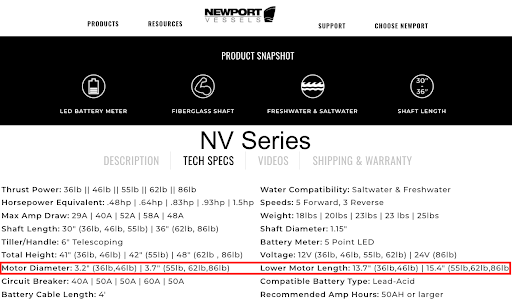
The propeller diameter for our Trolling Motors are as follows:
- 2 Blade Small: 8.9 inches
- 2 Blade Large: 11.25 inches
- 3 Blade Small: 8.9 inches
- 3 Blade Large: 10.10 inches
NK180
Our new brushless NK180 Electric Outboard Motor is integrated into the kayak. This system uses a four-bolt mount that connects to the stern of your kayak and cables that connect to your foot pedals to steer the kayak. Kayaks that are Power-Pole ready are compatible with this mount. If you are not sure if this will work with your kayak, please see our NK180 Compatibility Guide. Check out our NK180 YouTube Playlist to see how our NK180 motor can be installed on a kayak.
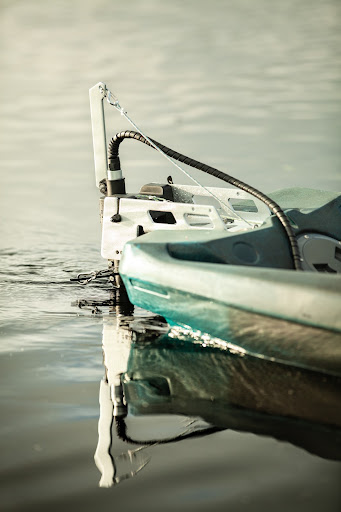
4. Battery Types, Amperage, and Weight
Trolling Motors
Our trolling motors require the use of deep cycle batteries. Our 36LB-62LB trolling motors require one 12v deep cycle battery and the 86LB thrust motors require a 24-volt system. The amperage rating of batteries will affect how long the battery can power the trolling motor. See our guide How to Calculate Run Time to determine what AH size battery you need for any Newport trolling motor.
Below are a few things you should consider when purchasing a battery.
- How long will you be using the motor?
- For example, you may go fishing for 6 hours but only use your motor for 2 1/2 hours.
- What speeds will you be using the most?
- Trolling motors draw more amps at higher speeds. Speed 5 draws the most power, requiring a larger battery compared to speeds 1-3 for the same amount of time.
- Multiple day camping and river trips:
- Customers on multi-day adventures should consider purchasing two batteries. For example, you can leave an extra battery in the car for day two of your trip if you are camping!
- Kayaks that have a larger storage area offer the option of storing larger batteries to travel further distances.
- Weight:
- Lead-acid marine batteries can weigh anywhere from 10 to 70lbs+. Batteries are often difficult to lift because of their weight. In addition, the handles can break, and they are cumbersome to carry around.
- The larger the amperage, the more it will weigh.
- The Smart Battery Box allows you to transport your battery easily. It can charge your phone or fishfinder, and it protects the battery from saltwater’s corrosive properties.
- Charging:
- It’s generally recommended to get a charger rated for 10% of the battery AH capacity. Our 12V Smart Battery Charger will help safely charge various batteries: GEL, SLA, Wet Cell, AGM, etcetera. It is built conveniently with alligator clips, is portable, and has an internal temperature reading to prevent overheating.
- Depth of Discharge (DOD):
- Many companies produce lead-acid batteries that have a cycle of roughly 80%, meaning you use 80% of the power and recharge it back to 100%.
- Depth of discharge is the amount of power you use and how many times you can recharge the battery.
- Check the maintenance section to ensure you are getting a battery that meets your needs. Discharging a battery will damage the battery.
NK180
Our NK180 Electric Outboard Motor utilizes a 24v system that is compatible with lithium or lead-acid batteries. Please see our Run-Time Calculator and choose lithium or lead-acid to get specific estimates for time and distance. For more information, see our NK180 FAQ Article.
For more in-depth information, check out our article “Deep Cycle Battery Overview.” In addition, we have a guide on What is the Right Trolling Motor Battery to help you find the battery that works for your setup. We often recommend this 35ah battery, this 55ah battery, this 70ah battery, or this 100ah battery on Amazon.
5. Pros and Cons of using Lithium Batteries
Trolling Motors
Many kayakers look to use 12V lithium batteries due to their reduced weight and a higher DOD or Depth of Discharge. However, most trolling motor companies do not recommend using lithium batteries. Many have a high voltage output of 14-16V when fully charged, which can wear down or damage DC Brushed motors (trolling motors). It is possible to find a lithium battery with an output rating of 13.8V or less, which will reduce the chance of damage to our motors.
Some customers may have already purchased a battery with a higher output voltage and will ask about using voltage limiters, buck converters, etcetera. You can try to use one of the devices, but you may experience voltage drop and decreased efficiency.
Please note special LED meters are needed to monitor the power of lithium batteries. Our Trolling motor and Smart battery box LED meters will not work with lithium batteries. For more information on this, please see this article on Our LED Battery Meters With Lithium Batteries.
NK180
Our NK180 Electric Outboard Motor can be used with a 24V Lithium or Lead-Acid setup. You can also use two 12V lithium batteries or two 12V lead-acid batteries connected in series to accomplish this. Please see our Recommended Batteries for the NK180 article for more information.
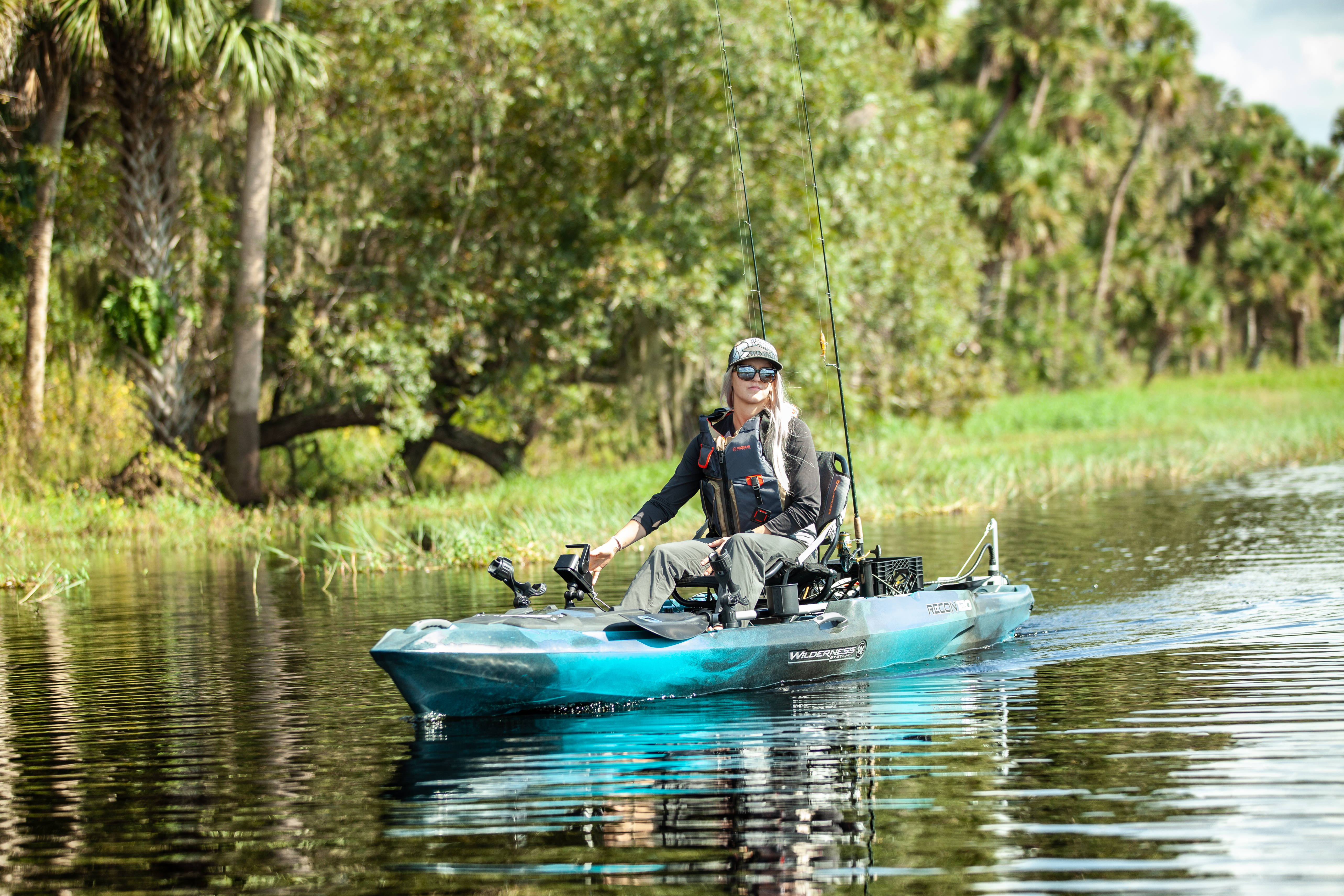
6. Where to Store a Battery on a Kayak?
Trolling Motors
When choosing a battery, it is crucial to determine where the battery will sit in the kayak. Some kayaks have a storage area with bungee cords that they use to secure the battery. We recommend using the front storage area to access the battery, the circuit breaker, and balancing weight. It is crucial to reach the circuit breaker, so you can reset it if it gets tripped. Remember, the USCG requires circuit breakers to be within 7” of the battery.
NK180
The NK180 has a speed controller with built-in overcurrent protection, a circuit breaker is not needed. The motor comes with an 8-foot power cord for the speed controller to ensure you can place this next to your seat. The screen on the speed controller will help you troubleshoot any propeller obstructions, surges in power, or overheating. Please refer to the manual for more information on this subject.
7. Are Extension Cables Needed?
Trolling Motors
All our motors have 4ft cables except for the Kayak Series, which features 5.5ft cables to attach to your battery. If you decide to store your battery on the other end of your boat, you may need an extension cable kit. You can find 5ft and 10ft options on our website. We use 8AWG marine tin coated wire with our extension kits. The kits come with hardware and tape to cover up the connections! For more information on extending your trolling motor wires, please see this short guide.
NK180
The NK180 has a 7ft battery cable, an 8ft cable for the variable speed controller, and an additional 5-foot extension cable kit for the battery cables. These are marine grade 10AWG wire. If you are extending your wires and want to know the voltage drop, you can use the Voltage Drop Calculator.
8. Propeller Sizes, Compatibility, and Benefits?
Trolling Motors
Each trolling motor has one size propeller it is compatible with. Once you determine the size, you can choose a two or three blade propeller.
2 blade props will have more efficiency, better handling in weeds but will produce less speed. 3 blade props have increased speed but less efficiency.
- 2 Blade Small: Designed for the 36lb, 40lb, & 46lb thrust Newport electric trolling motors (All Series)
- 3 Blade Small: Designed for the 36lb, 40lb, & 46lb thrust Newport electric trolling motors (All Series)
- 2 Blade Large: Designed for the 55lb, 62lb, & 86lb thrust Newport electric trolling motors (All Series)
- 3 Blade Large: Designed for the 55lb, 62lb, & 86lb thrust Newport electric trolling motors (All Series)
NK180
NK180 uses a 2 Blade Propeller, which is 5.9inches in diameter. There is only one propeller available, and it was designed exclusively for the NK180.
We do not test if other manufacturers' propellers will fit on our motors or vice versa. However, we would love some feedback on your findings if you use another propeller and have positive results.
9. How to Transport and Launch Your Kayak?
Getting a kayak in the water with a trolling motor can be tricky the first time. Kayak carts can be used to transport your kayak into the water quickly. There are two typical trolling motor setups with different tactics to get in the water safely.
Method 1: Side Mount
Side mounts are the most common because of the accessibility of the handle. A kayak cart is an excellent option for a side mount that is easy to install. Here are the steps to launching your kayak with a side mount
-
- Wheel or carry the kayak over to the water with the boat’s bow or front pointing towards the water.
- Attach your motor to your boat in a parallel orientation to ensure the motor does not touch the ground.
-
Connect the motor to the battery.
- Make sure you have enough weight on the opposite side to stabilize the boat.
- Make sure your motor is in neutral/speed 0.
- Push your kayak into the water about two feet and remove the c-tug.
- Swing your leg over the boat and sit down. Lean slightly to the opposite side of the motor to balance the kayak’s weight. Then, lift your legs inside the boat and paddle out to a safe depth.
- Now that you are deep enough into the water (2ft or more), use the motor mount to tilt the propeller back into the water. Ensure your propeller is 12 inches into the water (from the middle of the prop).
- Enjoy trolling around!
Method 2: Rear Mount: Trolling Motor or NK180
For a rear-mounted kayak, launching is very similar.
- Put the bow or the front of the boat into the water, paying extra attention to the motor to not hit the ground.
- Bring the boat into the water, so it’s deep enough to lower the motor and sit in without it touching the bottom of the water.
- Attach your Newport Tiller Extension Handle or ensure your speed controller is installed if you have an NK180.
- Swing your leg over the boat and put your foot on the ground.
- Sit down and lift your feet into the boat.
- Start trolling around!
If you have any additional questions about our motors, please see our Motors FAQ Page. For more in-depth articles, please visit our Resource Guides page. If you can’t find the information you need, give us a call (866) 721-0002 Monday to Friday: 8:30 am - 4:30 pm PST or reach out to us via email SUPPORT@NEWPORTVESSELS.COM.

